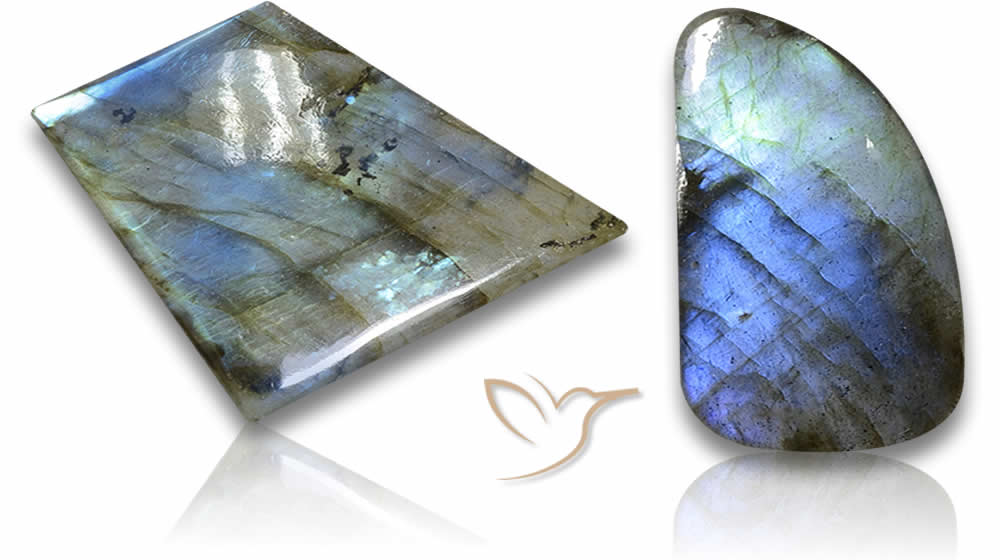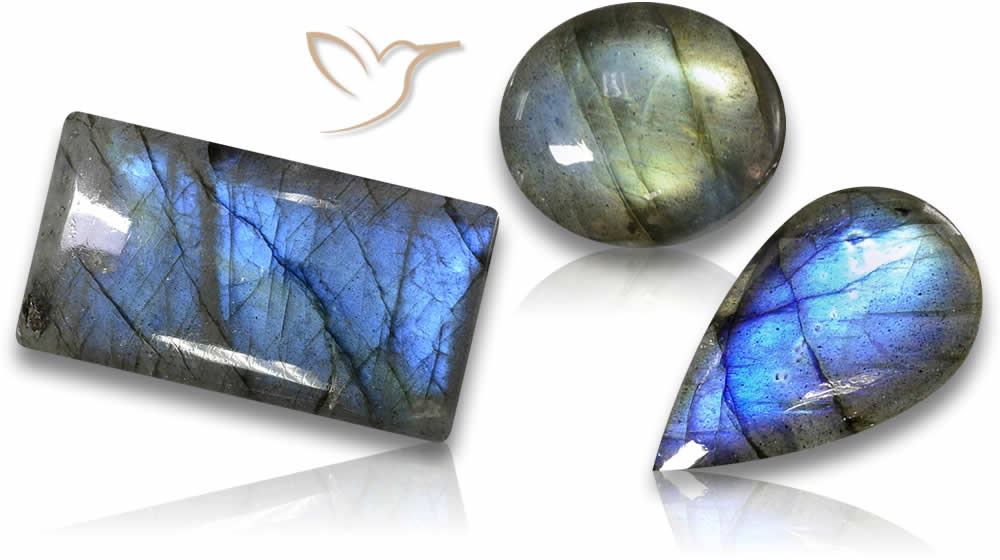Labradorite Iridescence: Unveil the Mystic Glow

Labradorite is a mesmerizing gemstone known for its captivating iridescence, a phenomenon that causes its surface to display a stunning play of colors as it moves in the light. This unique optical effect, often referred to as "labradorescence," gives the stone a magical quality, with flashes of blue, green, gold, and even violet shimmering from within. Found in locations such as Canada, Madagascar, and Finland, labradorite gemstone has become a favorite among gem enthusiasts and jewelers for its otherworldly beauty. Labradorite's iridescence makes each piece unique, transforming it from a simple mineral into a striking, eye-catching treasure in both fine jewelry and decorative arts.
Disclaimer: Claims about the healing or spiritual properties of labradorite mentioned in this article are based on traditional beliefs and cultural legends. They are not supported by scientific evidence and should not be used as a substitute for professional medical advice.
Key Takeaways
- Labradorite Iridescence is a unique play of colors that evokes awe and admiration.
- Its mesmerizing beauty and soothing properties make it a popular choice for jewelry enthusiasts.
- Labradorite has a rich historical significance that dates back to ancient cultures and civilizations.
- The gemstone's cutting techniques highlight its iridescence and beauty.
- Labradorite jewelry designs can be both stunning and unique.
Understanding Labradorite: A Gemstone of Mystique and Beauty
Labradorite stands out as a fascinating gemstone that draws people in with its mesmerizing play of colors and unique iridescence. It's no wonder it has become such a go-to option for jewelry lovers and collectors. Let's dive into the key characteristics and properties that give labradorite its special mystique and appeal.
| Property | Description |
|---|---|
| Color | Labradorite boasts a range of hues, from deep blues and greens to flashes of gold and purple, thanks to its unique mineral composition and light interference. |
| Luster | Labradorite's iridescence and attractive sheen give it a luminous quality that enhances its beauty and appeal. |
| Hardness | With a rating of 6 to 6.5 on the Mohs scale of hardness, Labradorite is a durable gemstone that can withstand daily wear and tear. |
| Cleavage | Labradorite has perfect cleavage, which means it can be easily split into thin sheets or layers in one direction. |
| Transparency | Labradorite is typically opaque, with occasional transparent or translucent specimens. |
These distinctive traits really set labradorite apart from other gemstones. That iridescence, resulting from light scattering on internal structures, is especially captivating and explains why it's so valued by designers and collectors.
A Glimpse into Labradorite's Rich History
The tale of labradorite gems begins in the 18th century, when Moravian missionaries first discovered it in Labrador, Canada. Historical accounts say the missionaries were traveling through the region and were instantly drawn to its beautiful iridescent qualities. But it wasn't until the 19th century that labradorite got its official name and recognition as a distinct gemstone.
Over the centuries, labradorite has been celebrated for its mystical attributes and has played roles in different cultures for spiritual and healing uses. A legend from Canadian Eskimo traditions tells how the Northern Lights were once imprisoned in coastal rocks in Labrador. A brave warrior struck the rocks with his spear, releasing most of the lights - but some remained trapped, creating the stone we know as labradorite.
In various other societies, people viewed the gemstone as having protective and purifying abilities, helping to repel negative influences and foster inner calm.
| Time Period | Events |
|---|---|
| Ancient Times | Labradorite was believed to have protective and healing properties in various ancient cultures and civilizations |
| 18th Century | Labradorite was discovered by Moravian missionaries in Labrador, Canada |
| 19th Century | Labradorite was officially named and recognized as a unique gemstone |
| 20th Century | Labradorite became popular among jewelry designers and collectors |
These days, labradorite remains a top pick in the jewelry world. Its shimmering effects and storied past appeal to those who want pieces with depth and a touch of mystery.
The Beauty of Labradorite: Color and Luster
Labradorite earns its reputation through an incredible array of colors and luster that sparks the interest of jewelry fans and gem collectors alike. The special optical phenomenon behind the iridescent colors of labradorite is labradorescence, happening when light enters the stone and bends inside.
The shades of labradorescence span from vibrant blues and greens to gentle hints of gold and purple, lending a mesmerizing, almost enchanted vibe. As light strikes the stone from various directions, the colors shift, adding a dynamic sense of flow and dimension.
Labradorite Color
The exact color of labradorite depends on factors like crystal size, orientation, and the light's angle and intensity. You'll often see blues, greens, and yellows dancing in the light.
That said, labradorite isn't restricted to those tones. Some pieces show broader palettes, including oranges, pinks, reds, and browns. These uncommon varieties, prized by many, go by the name spectrolite, a special type of labradorite from Finland.
Labradorite Luster
Labradorite shines with a distinctive luster that boosts its overall charm. It features a vitreous, glass-like sheen for a sleek, refined polish.
Beyond that, it can show a metallic glow, intensifying its iridescence and making it appear more radiant. This quality brings an extra captivating layer to labradorite jewelry, positioning it as a standout choice for any setting.
All in all, the blend of labradorite's vivid colors and luster makes it an essential addition to any gem collection. Whether you're eyeing a bold necklace or a subtle ring, its ethereal charm is bound to draw you in.
Mastering the Art of Labradorite Cutting
With its iridescence and distinctive color play, labradorite ranks high among favorites for jewelry makers and collectors. To truly bring out its potential, though, it needs precise cutting and polishing. Here, we'll look at various cutting methods that help reveal labradorite's standout features.

Cabochon Cutting
For softer, translucent stones like labradorite, cabochon cutting is a common approach. It features a domed top and flat bottom, emphasizing the iridescence as light travels through the curve. Cabochons appear in shapes such as oval, pear, or round, often seen in pendants and earrings.
Fancy Cutting
Cuts like pear, marquise, or trillion accentuate labradorite's traits. Their larger surfaces allow more color variation, ideal for bold items like pendants or rings. Mixing cuts can lead to detailed designs that highlight labradorite's otherworldly appeal.
Faceted Cutting
Another favored method for stones like labradorite is faceting. These cuts involve multiple flat planes, differing from cabochons. They draw out a different elegance by boosting luster and color depth. Faceted labradorite works well in rings, earrings, and necklaces, sparkling under light.
The Artistic Process
As a valuable gem, labradorite demands skilled handling in cutting. It starts with raw stones that get sorted and assessed. Then, cutting and polishing happen in phases, smoothing out imperfections until the ideal form and shine emerge. A seasoned cutter tailors each approach to the stone's individual shape and qualities for the best outcome.
Jewelry Design Ideas: Harnessing the Magic of Labradorite Iridescence
Labradorite sparks creativity and opens doors for artistic flair, which is why designers love working with it. Tapping into its iridescent magic offers countless ways to craft standout pieces. Check out these labradorite jewelry design ideas to fuel your next creation:
Statement Necklace
Go big with a statement necklace featuring a prominent labradorite center stone. Team it with accents like moonstone or amethyst to echo the iridescence. Add detailed metal elements and chains for extra flair.
Delicate Ring
A slim ring with a modest labradorite can deliver a subtle yet powerful impact. A basic bezel or prong setting keeps it classic and enduring.
Drop Earrings
Highlight labradorite's color shifts with drop earrings. Opt for elongated stones that sway and reflect light beautifully. Play with metal tones and hook styles to match the hues.
Layered Bracelet
Stacking bracelets of varying styles is all the rage. Weaving labradorite beads into the mix creates a fresh vibe. Go for faceted or polished beads to build texture.
Bohemian Anklet
Thanks to its grounded, mystical vibe, labradorite fits right into boho accessories. Craft a straightforward anklet with tiny labradorite pieces and a fine gold chain. It's a low-key way to add intrigue to your look.
"Labradorite's distinct iridescence can transform any piece of jewelry into a work of art."
Conclusion
To wrap things up, labradorite iridescence draws us in with its mystical shine. We've journeyed through the captivating realm of labradorite, examining its special traits, deep history, and stunning visuals. From its color spectrum and sheen to the skill in cutting and the inventive ways to use it in jewelry, labradorite keeps enchanting those who appreciate fine pieces.
If you're brainstorming your next jewelry project, why not give labradorite a try? It can turn bold statements or gentle touches into something truly special.
Thanks for exploring the world of labradorite iridescence with us. Hopefully, this has sparked some ideas and encouraged you to learn more about labradorite gemstone properties and uses.
Frequently Asked Questions
What is the iridescence of Labradorite?
Labradorite is known for its mesmerizing iridescence, which is the play of colors that shimmer and change as the stone is viewed from different angles. This iridescence is caused by the scattering of light within the thin layers of minerals within the stone.
What are the properties of Labradorite?
Labradorite possesses a variety of properties that make it unique and desirable. It is believed to enhance intuition, protect against negative energies, and promote spiritual growth. Additionally, Labradorite is valued for its durability and is commonly used in jewelry due to its relatively high hardness on the Mohs scale.
What is the history of Labradorite?
Labradorite has a rich history that dates back centuries. It was first discovered in Labrador, Canada, in the late 18th century. Labradorite holds significance in various cultures, including the indigenous Inuit people who believed that the stone trapped the Northern Lights. It has also been used by ancient civilizations for its mystical and protective properties.
What colors and luster can be found in Labradorite?
Labradorite exhibits a wide range of colors, but its dominant hues are typically blue, green, and gray. These colors are accompanied by mesmerizing flashes of gold, orange, purple, and sometimes even pink. The luster of Labradorite can vary from a soft glow to a vibrant and striking shine, depending on the quality and cut of the stone.
How is Labradorite cut to showcase its iridescence?
Labradorite is cut in various ways to maximize its iridescence. Cabochon cuts are commonly used to create a smooth, rounded surface that showcases the stone's play of colors. Faceted cuts, on the other hand, highlight the reflective surfaces and add a mesmerizing sparkle to the gemstone.
What are some jewelry design ideas incorporating Labradorite?
Labradorite's unique beauty makes it a versatile gemstone for jewelry design. It can be used as a focal point in statement necklaces or incorporated into intricate earrings. Labradorite can also be combined with other gemstones to create stunning, one-of-a-kind pieces. Its iridescence adds a touch of enchantment and mystery to any jewelry design.

